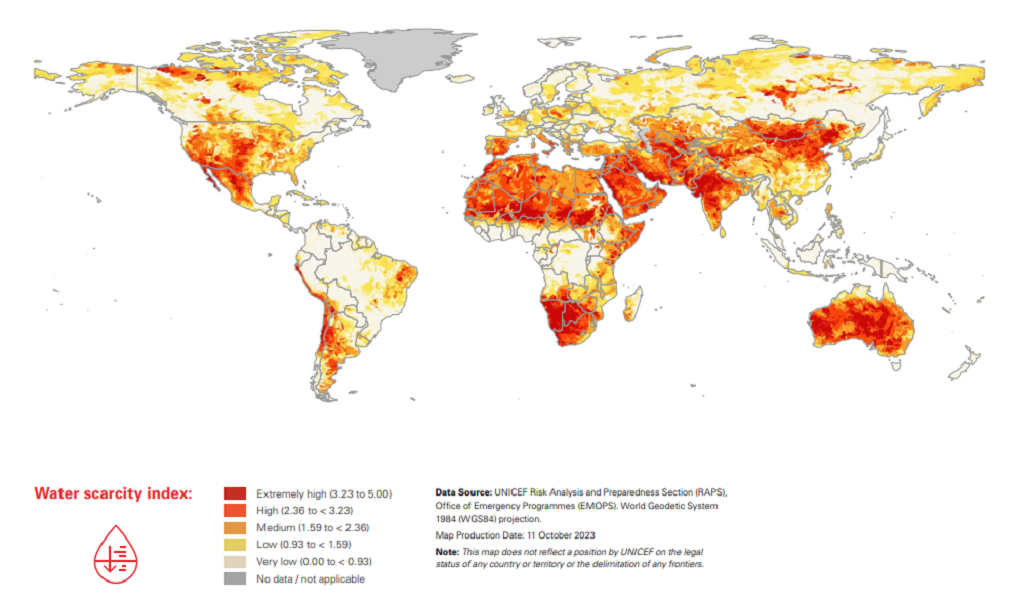Released days ahead of COP28, the report sees global event as a critical opportunity to finally put children on the climate change agenda
About half of the world’s children (953 million) were exposed to high or extremely high water stress in 2022, according to a new UNICEF report.
The situation is set to become more severe due to climate change, the authors of the report warned, stressing on the need to have children at the centre of global response.
In 2022, 739 million children worldwide were exposed to high or extremely high water scarcity and 436 million children lived in areas with high or extremely high water vulnerability, according to the UNICEF report released ahead of the 28th Conference of Parties (COP28) to the United Nations Framework Convention on Climate Change to begin in Dubai on November 30.
Water scarcity index, 2022

“COP28 cannot be business as usual. We cannot keep going down the same path. Let’s ensure that COP28 becomes a turning point in finally putting children at the centre in our shared fight against climate change,” UNICEF Executive Director Catherine Russell said.
The report also captured how the various climate and environmental shocks driven by climate change are impacting the lives of children.
Building on the Children’s Climate Risk Index (CCRI) released in 2021, the authors found that 559 million children are currently exposed to high heatwave frequency. This can impact all the 2.02 billion children globally by 2050, the new report added. Around 470 million children, as of 2022, faced high or extremely high drought risk, the report noted.

The 2021 report findings had predicted that nearly all children would be exposed to at least one major climate and environmental hazard, shock or stress. Whereas, this report underlined that by 2022 a large number of children were already living in areas of high or extremely high water vulnerability, characterised by low or very low levels of drinking water service combined with high or very high risk of water stress. These risks were compounded by interannual variability, seasonal variability, groundwater decline and drought.
UNICEF also described how the health of children is affected by extreme weather events like floods that are linked with climate change.
Floods compromise safe water supply, damage sanitation facilities and occur in areas grappling with open defecation issues, leading to contamination of water. This can make way for outbreaks of diseases like diarrhoea, the report stated.
“Child malnutrition is worsened by crop failures and rising food prices, exacerbated by higher temperatures and increased rainfall linked to climate change,” the authors noted.
The report further asserted that confronting the planetary crisis for children requires a global movement of partnership.
This year, UNICEF is launching the Sustainability and Climate Action Plan, which commit to galvanising efforts to fill global gaps to protect the most vulnerable children, it stated in the document.
Putting children on climate change agenda
Mentioning that it sees COP28 as a critical opportunity to finally put children on the climate change agenda, UNICEF called for embedding children and intergenerational equity in the Global Stocktake.
Global Stocktake is a process for countries and stakeholders to see where they are collectively making progress towards meeting the goals of the Paris Climate Change Agreement and where they are not.

Through the document, it also pitched for inclusion of children and climate-resilient essential services within the final decision on the Global Goal on Adaptation (GGA).
GGA collective commitment under Article 7.1 of the Paris Agreement is aimed at “enhancing” (the world’s) adaptive capacity, strengthening resilience, and reducing vulnerability to climate change.
Ahead of COP28, the child rights body also called for making the Loss and Damage Fund and funding arrangements child-responsive. These, it hinted, could be made a reality with child rights embedded in the fund’s governance and decision-making process.
The fund is aimed to provide financial assistance to countries most vulnerable and impacted by the effects of climate change and was a highlight at COP27.
We are a voice to you; you have been a support to us. Together we build journalism that is independent, credible and fearless. You can further help us by making a donation. This will mean a lot for our ability to bring you news, perspectives and analysis from the ground so that we can make change together.














































